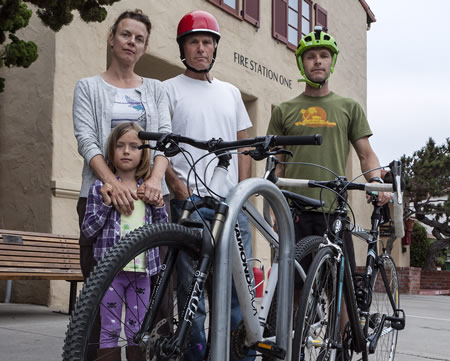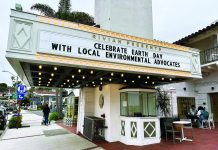
Billy Fried, Max Isles and Tamara Hlava are fed up with the city’s dearth of safe routes for pedestrians and cyclists.
For the trio, the car-on-bike accident that fatally injured 55-year-old Laguna Beach bicyclist John Greg Colvin on North Coast Highway June 17 served as a catalyst.
“We were all so outraged that we decided to take some action,” said Fried, who invited Hlava and Isles to join him on his KX 93.5 FM radio talk show just two days after the incident to discuss what they see as an untenable situation. “We don’t want to take another death,” he said.
The crusaders have now established Livable Streets Laguna and plan a rally at 5:30 p.m. on Tuesday, July 15, prior to the City Council meeting, to demonstrate the breadth of public support for making street safety improvements for non-motorists a priority.
Livable Streets Laguna hopes to build grassroots support by reaching out to some of the city’s most politically active constituencies, including groups such as Let Laguna Vote and Village Laguna, said Fried. And Transition Laguna Beach has already called members to the rally in a recent e-mail blast.
“There seems to be a groundswell of people who are outraged,” Fried said, including Colvin’s widow who told him she would attend the July 15 event.
“It’s embarrassing that Laguna is so backwards in pedestrian and bike mobility,” said Isles, a co-founder of Transition Laguna. Especially critical of the town’s lack of infrastructure for non-motorists, he also laments the lack of street awareness among motorists, pedestrians and cyclists for each other.
Livable Streets calls for accessible goals such as improved sidewalks, the installation of blinking lights at all major crosswalks, more bike racks, a bike share program, and extending non-highway alternative bike routes through town. Currently sharrows and signage direct cyclists off Coast Highway in limited sections of town.
The Livable Streets proponents also advocate significant and potentially costly infrastructure changes to slow traffic by lowering speed limits, narrowing lanes, and adding roundabouts.
Ultimately, the city needs to take control of Coast Highway and Laguna Canyon Road, where most fatalities occur, and re-engineer them to make room for separate bike lanes and pedestrians, said Fried.
Since both roads are state highways, such an undertaking would require an appeal for local control from the state Department of Transportation.
Reducing congestion and “the dangers of our car-dependent culture,” are among the core interests of Let Laguna Vote, said Rita Conn, founder of the vocal group whose opposition helped defeat the village entrance parking structure last year.
The organization has urged some city leaders to consider Vision Zero, a global movement whose adherents advocate zero as the only tolerable number of serious injuries and death on local roads, said Conn. Though many individual members of Let Laguna Vote back Fried’s goals, the organization seeks more details before officially endorsing the initiative, she said.
Even so, the group is already exploring common ground with Livable Streets. At its next meeting, the group will debate the potential fiscal and legal ramifications of wresting control of Coast Highway and Laguna Canyon Road from Caltrans, she said.
Fried, Isles and Hlava were all members of Laguna’s complete streets task force, formed in 2009 to help the city establish priorities for compliance with the state’s 2008 law mandating equitable access on roadways for all users. Early efforts spawned some bike racks and sharrows, but now it’s basically dormant, said Fried.
In the last year, the city has hired two consultants, one to evaluate improvements to the city’s public transit system, and the other to develop a network that accounts for the needs of pedestrians, cyclists and motorists and includes reliable public transit options.
The city also commissioned a consultant to assess pedestrian and bike access options on Laguna Canyon Road. A preliminary report on the effort may be presented to the Council this month, according to a city memo.
Studies may be a start, but Fried is ready to move. “We talk the talk about being a European town, but we don’t walk the walk,” he said.





[…] residents band together to demand safer streets following the death of cyclist Greg […]
[…] front page article, “Tragedy Sparks Safe Street Crusade” was excellent. As a homeowner along Monterey Drive in the North Laguna “tree streets” we walk […]
[…] front page article, “Tragedy Sparks Safe Street Crusade” was excellent. As a homeowner along Monterey Drive in the North Laguna “tree streets” […]
[…] Source […]